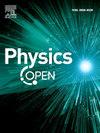由对称变换引起的一维元胞自动机的轨道
IF 1.4
Q2 Physics and Astronomy
引用次数: 0
摘要
利用群论的方法,给出了由反射和置换对称操作及其乘积引起的一维元胞自动机规则集的等价类(也称为轨道)的确定方法。轨道按其同构类型分类。包含大小为2和3的状态集的轨道数和按类型划分的轨道数的结果。本文章由计算机程序翻译,如有差异,请以英文原文为准。
Orbits of one-dimensional cellular automata induced by symmetry transformations
Using a group-theoretic approach, a method for determining the equivalence classes (also called orbits) of the set of rules of one-dimensional cellular automata induced by the symmetry operations of reflection and permutation and their product is presented. Orbits are classified by their isomorphism type. Results for the number of orbits and the number of orbits by type for state sets of size two and three are included.
求助全文
通过发布文献求助,成功后即可免费获取论文全文。
去求助
来源期刊

Physics Open
Physics and Astronomy-Physics and Astronomy (all)
CiteScore
3.20
自引率
0.00%
发文量
19
审稿时长
9 weeks
 求助内容:
求助内容: 应助结果提醒方式:
应助结果提醒方式:


